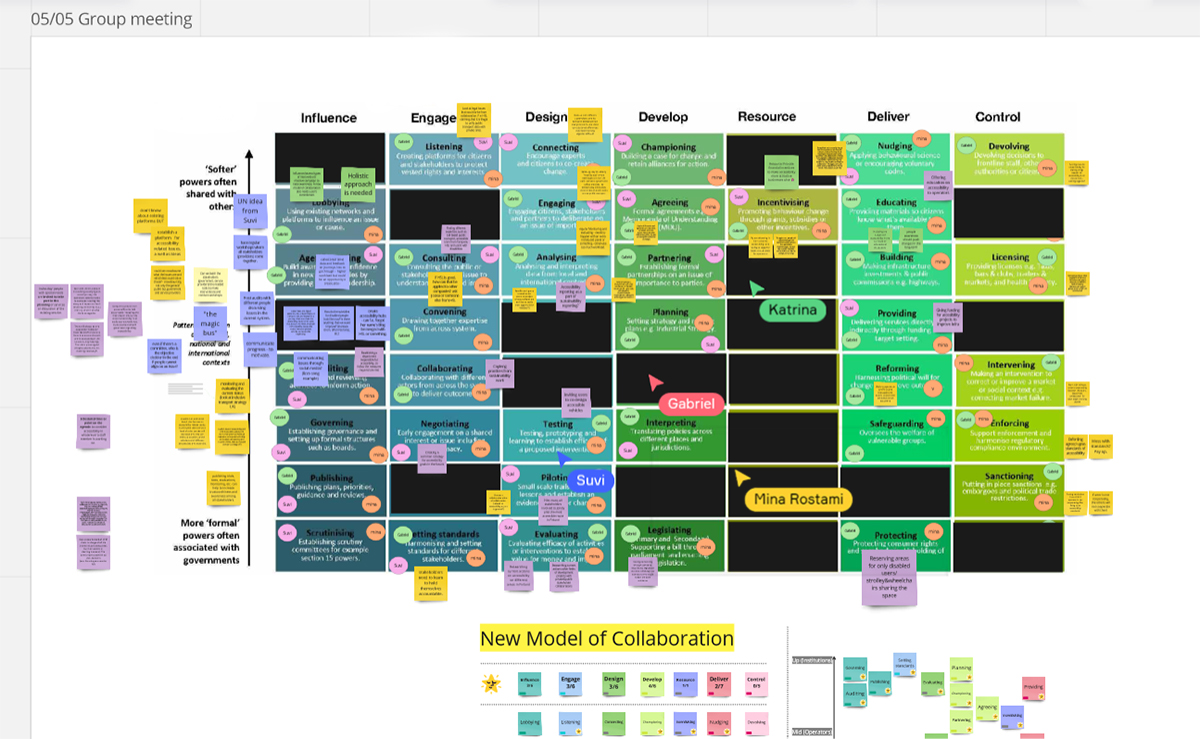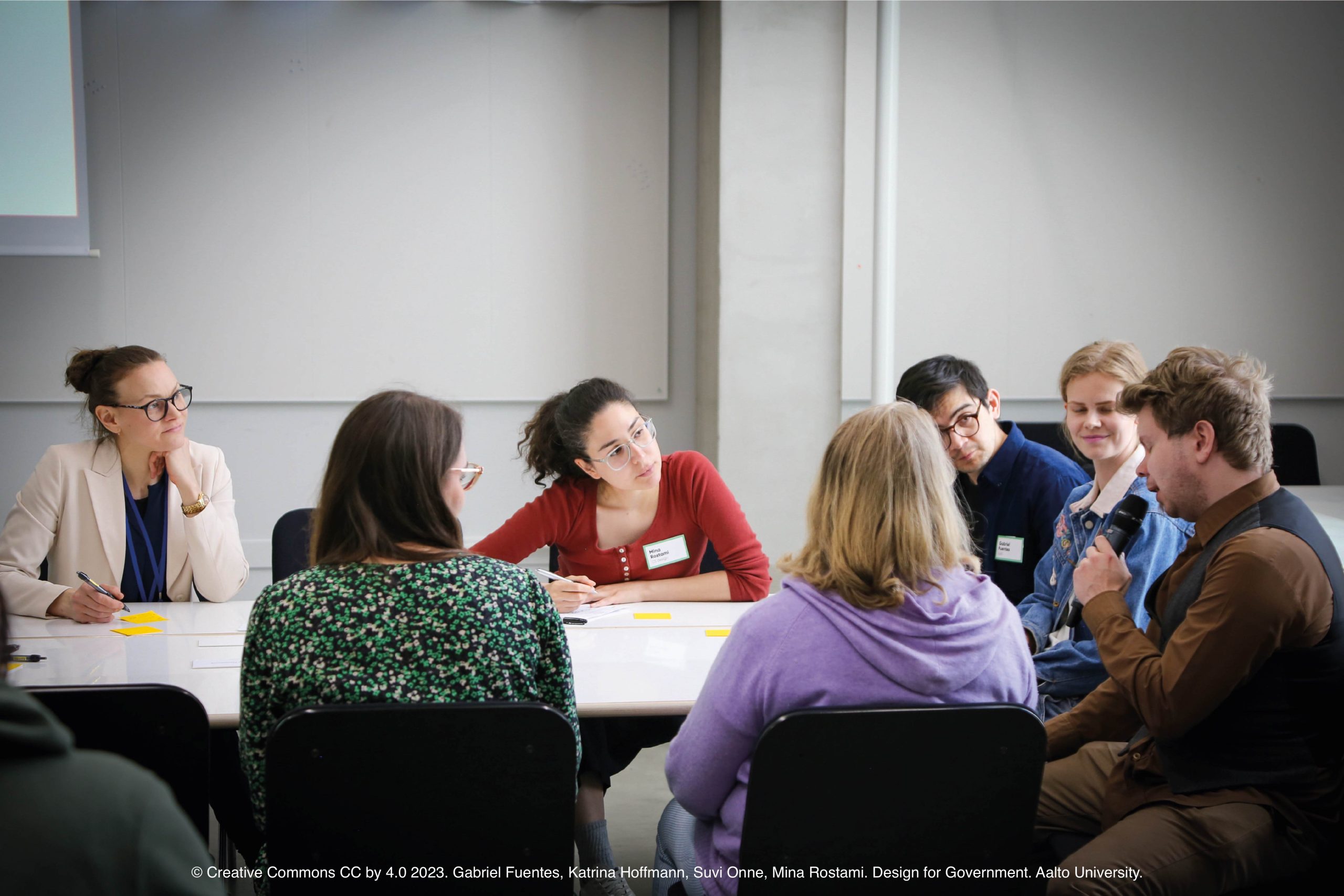This blog post reports on work-in-progress within the DfG course! The post is written by Mina Rostami, a member of group 2A. Together, we work in collaboration with the Ministry of Transport & Communications’ brief on ‘how to make Finland’s public transport system more accessible’. The group 2A includes Gabriel Fuentes from the Collaborative & Industrial Design program, Katrina Hoffmann from the Collaborative & Industrial Design program, Suvi Onne from the Creative Sustainability – Chemical engineering program, and Mina Rostami from the Creative Sustainability – Design program.
Written by: Mina Rostami
The basis for intervening in any system is identifying the needs of the stakeholders, understanding the constraints of the project, validating key insights, and developing creative solutions that meet the requirements.
To achieve that, Gabriel, Katrina, Suvi, and I met two weeks after the period break, which allowed us to digest the information from the last event – the midterm presentation. The purpose of the midterm was to update our partners, both the ministry and the service providers, about our process. At the same time, for us, this was a big opportunity to receive feedback on our process and align on the direction we are taking.
A classic case of fail, explore and repeat.
Despite just having come back from our little break, the next meet-up with the stakeholders was already coming closer. The purpose? An ideation workshop. Crucial for moving forward in our design process.
With the power of storytelling and creating scenarios, we aimed to make our insights more tangible for the participants, while creating a space that allowed for the generation of ideas. The many interviews and datasets we analyzed helped create our fictional characters Mikko and Anna. These two narratives highlight the perception of travel chains, both from a user’s, as well as a service provider’s perspective. With the story in our bags, the challenge remaining was to create and encourage engagement with the stakeholders.


On the day of the ideation workshop, we introduced the stories of Mikko and Anna along with three key points linked to the narratives. Equipped with questions and examples of good practices, we expected a heated discussion between the stakeholders and ideas flying from left to right. However, shifting from planning to action usually makes for a lot of adaptation and being flexible. During the session, we mostly engaged in a conversation. Looking back, I realize there were still many things to be said before getting to ideating.
By the end, our expectations as designers of processes made us think that we needed to have a lot of ideas ready to be worked on. Yet, this is not always the case with such complex problems. At the end of our session, we managed to create a commitment to what needed the most attention at the moment: Collaboration and common standards. At the same time, we realized that as a team, we needed to decode where those ideas were within the conversations that unfolded. In short, time to roll our sleeves up.
The ideation workshop was a good exercise to learn from. Through this, we learned a lot about tackling big problems, and what kind of participation is needed to unlock engagement, and agency to take action. Creating bite-sized information can help people digest the content and be more engaged. Giving the stakeholders the opportunity to choose between several key points by voting, followed by a discussion, could create engagement, at the same time clarifying the needs of the participants.
Ultimately, we realized this became a point of exploration for us. That, adapting to changing processes and outcomes is just a point of improvement. Exploration is, after all, driven by failure.
Intervening in the system: work in progress
The workshop set a basis for further progress in the project. We analyzed the feedback from the stakeholders and settled for a direction. Currently, we are in the process of generating action plans to tackle the issues that we have discovered. Along the way, different methods act as tools to take steps toward defining a design intervention. In our view, a design intervention is a designed action plan that disrupts the status to move towards a desired state.
‘Government as a System’, created by Policy Lab (Siodmok, 2020), and the ‘Leverage Points’, introduced by D. Meadows (‘Leverage Points’, n. d.) were game-changers for us. These resources sparked our creativity, providing invaluable insights and fresh perspectives that guided us in shaping our design intervention.
The ‘Government as a System’ toolkit describes 56 different ways of developing new ideas for policy, which helped A LOT when it came to brainstorming different proposals in our direction. In fact, it led to so many ideas, so many pathways, and only more ways to go forward.

Our group’s Miro board shows how we used the ‘Government as a System’ map (Siodmok, 2020).
Finally, the leverage Points by D. Meadows (‘Leverage Points’, n.d.) served as a tool to design with the intention of change in mind. These points represent strategic areas within a system where interventions can have a disproportionate impact, such as challenging prevailing paradigms, stimulating systemic shifts, and unlocking new patterns. We compared our direction with the points, identified overlapping parts, and specified our focus area.

Donella Meadows ‘Leverage Points’ shown as a graph (Leverage Points, n. d.)
In our ongoing journey to intervene in the system, we have encountered both breakthroughs and valuable lessons along the way. From the ideation workshop to analyzing stakeholder feedback, we have gained insights that have propelled us forward. We explored new avenues and adapted our approach.
As we continue crafting action plans and defining our design intervention, we find inspiration in the ‘Government as a System’ toolkit and the concept of ‘Leverage Points’ by D. Meadows. These resources have sparked our creativity and guided us toward strategic areas for intervention. Now, the pivotal moment lies ahead: defining how our design intervention will impact the future and what new patterns will emerge.
As we dive into this defining phase, we embrace the challenge with excitement and determination, eager to make a tangible difference. Stay tuned.
References:
Leverage Points. (n. d.). [Graph]. Accessed 11. May 2023, from https://ecowe.files.wordpress.com/2013/02/04_pivot_points.png
Leverage Points: Places to Intervene in a System. (n. d.). The Academy for Systems Change. Accessed 11. May 2023, from https://donellameadows.org/archives/leverage-points-places-to-intervene-in-a-system/
Siodmok, A. (2020, March 6). Introducing a ‘Government as a System’ toolkit—Policy Lab. https://openpolicy.blog.gov.uk/2020/03/06/introducing-a-government-as-a-system-toolkit/
The DfG course runs for 14 weeks each spring – the 2023 course has now started and runs from 27 th February to 31 May. It’s an advanced studio course in which students work in multidisciplinary teams to address project briefs commissioned by governmental ministries in Finland. The course proceeds through the spring as a series of teaching modules in which various research and design methods are applied to address the project briefs. Blog posts are written by student groups, in which they share news, experiences, and insights from within the course activities and their project development. More information here about the DfG 2023 project briefs. Hold the date for the public finale live at 13:00-16:00 AM (EEST) on Wednesday, 31 May at Musiikkitalo!

